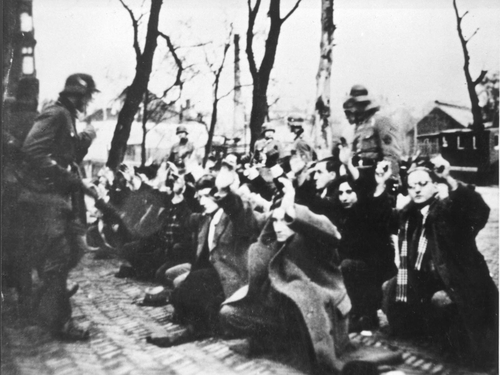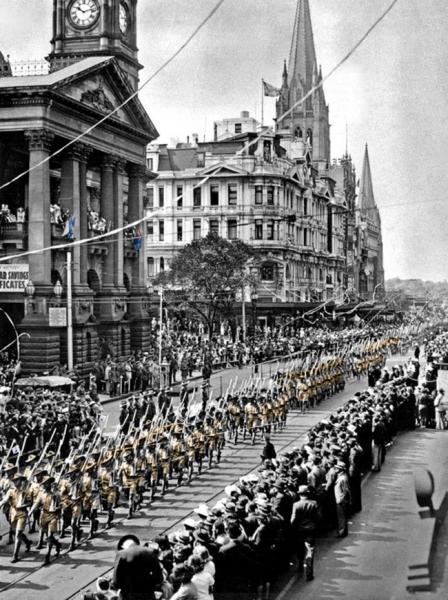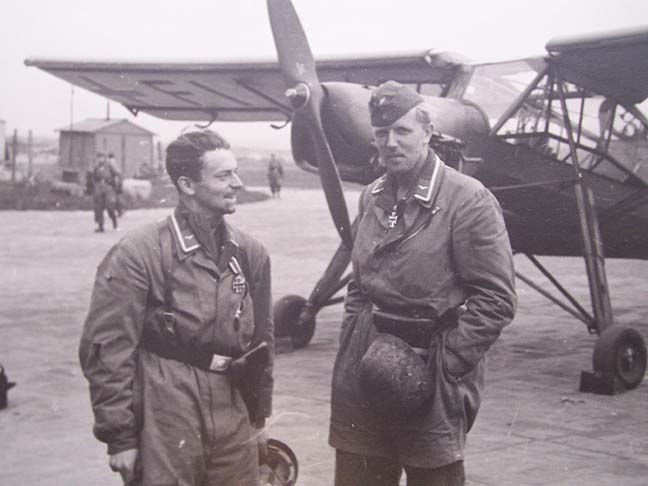Saturday 22 February 1941
 |
| Jews rounded up in Amsterdam, 22 February 1941. |
Italian/Greek Campaign: British Foreign Secretary Anthony Eden and CIGS Sir John Dill move on from Cairo to Athens today,
22 February 1941, having also made a top-secret visit to Malta as well. Accompanying them are Mediterranean Royal Navy commander Admiral Cunningham and Air Marshal Longmore. They meet with King George II, Commander in chief Alexander Papagos and the government, who continue the Metaxas position that insufficient British troops would be worse than none at all. The two sides also disagree on proper strategy, with the Greeks wishing to defend the fortified Metaxas line at the frontier and the British preferring a line further back. However, ultimately the British convince the Greeks to accept a British expeditionary force.
East African Campaign: The 12th African Division and Gold Coast Brigade attack Jelib frontally while another force, 1/1 King's African Rifles, comes in from the rear. The 22nd East African Brigade cuts the road to Mogadishu, blocking the Italians from retreating. The action begins at 05:45, and the Italian Colonial Infantry rapidly gives way. The British advance in armored cars and brush aside all resistance. By 13:00, the 12th African Division takes Jelib, which effectively ends Italian resistance on the key Juba River line. Firefights continue in the area throughout the afternoon, but the Italians are sent into full retreat. They try to establish another line between the river and Mogadishu, but the Italian command had staked everything on defending the river and have nothing in reserve. Some 30,000 Italian troops (mostly native) are either killed, captured or fleeing in wild terror.
Royal Navy cruiser HMS Shropshire sits offshore and bombards Brava. General Cunningham cables Middle East Commander General Archibald Wavell in Cairo, telling him that his forces can continue operations toward Harar, some 800 miles beyond Mogadishu.
British troops take Cub Cub from the 112th Colonial Battalion.
 |
| "William Wyckoff, of the American-Scandinavian Field Hospital in Norway, x-rays a British boy in his bed at the American Hospital in Britain in February 1941. Wyckoff had previously been stationed at Namsos in Norway." This is the Park Prewett Hospital in Basingstoke, Hampshire. © IWM (D 2068). |
European Air Operations: RAF Bomber Command attacks Brest during the night with 42 bombers. Admiral Hipper is still in port but escapes damage.
The Luftwaffe switches targets after dark. It sends 17 bombers against the port of Hull. There are many deaths, and extensive damage is caused by aerial mines.
Australian Prime Minister Robert Menzies, visiting London, provides a fresh and objective perspective on the effects of the Blitz in his diary. He notes that:
Once you get past St. Paul's, you come on whole blocks of which only an occasional twisted girder or brick wall remains.
This also is what contemporary photos show. However, the British press for one reason or another is minimizing the extent of the devastation by using such tricks as cropping photos to show St. Paul's and not the devastation around it.
RAF No. 317 "Wilno" (Polish) Fighter Squadron forms at RAF Acklington.
 |
| "Onboard a convoy vessel on patrol. Firing the starboard depth charge throwers." 22 February 1941. © IWM (HU 110317). |
Battle of the Atlantic: Admiral Lütjens, commander of Operation Berlin in the North Atlantic, has been searching daily for targets for his heavy cruisers Scharnhorst (Kapitan Kurt Caesar Hoffmann) and Gneisenau (Kapitan Otto Fein). Several days have passed, and nothing so far.
Today, his luck changes. At about 10:55, the lookouts spot a convoy heading west. This means that the ships are empty... but they are still worthy targets. Best of all, they appear to have no escorts at all. The two cruisers move in for the kill, but the ships disperse as soon as they see the German warships. During the entire engagement, they sink the following:
- British tanker Lustrous (6156 tons)
- British freighter Kantara (3237 tons)
- British freighter Trelawny (4689 tons, one death)
- British freighter A. D. Huff (5866 tons, ten deaths)
- British freighter Harlesden (5483 tons, seven deaths)
Scharnhorst sinks the Lustrous, while Gneisenau sinks the A.D. Huff and Trelawny. The two ships combine to destroy the Kantara (that must have been quick work). After dispatching these ships, Lütjens orders his seaplane aloft, and it spots the Harlesden about fifty miles away. Fortunately, as they are trained to do, the crew of the Arado seaplane destroys the Harlesden's radio aerial. After a long chase, Gneisenau sinks this fifth victim. All told, 25,431 tons of precious Allied shipping is sent to the bottom. Lütjens takes 180 prisoners, and the merchantmen crews suffer only 18 deaths - a relatively small number for so many ships sunk in the middle of the Atlantic without escorts.
Then, an event full of portent happens. Lütjens, of his own initiative, decides to send a radio report to Berlin detailing his force's success against the convoy. This, of course, ensures that his force's success will make the next day's propaganda broadcasts, which is highly prized in the Wehrmacht. Anyone familiar with the voyage of battleship Bismarck will recognize instantly that this unnecessary message-sending is a Lütjens trademark. It does not cost him anything... this time.
Lütjens now decides to move on, knowing that the surviving members of the convoy would have signaled the Royal Navy about his position. He signals tankers Schlettstadt and Esso Hamburg to meet him far to the south, near the Azores. The German ships steam on, unmolested and victorious.
U-96 (Heinrich Lehmann-Willenbrock) is lurking around the shipping lanes northwest of Ireland on its third patrol when it spots an abandoned tanker west of the Hebrides. It is 6999-ton British tanker Scottish Standard, which the Luftwaffe bombed on the 21st. The crew has abandoned ship, but there is a destroyer, HMS Montgomery, standing guard. Lehmann-Willenbrock quickly puts two torpedoes into the tanker, finally sinking it, then dives to avoid the inevitable escort attack. The Montgomery spends five hours and drops 37 depth charges, but U-96 gets away. There are five deaths.
Royal Navy destroyer HMS Montgomery, which rescued the survivors of the Scottish Standard, spots a submarine - but it isn't U-96. Instead, it is the Italian submarine Marcello. The Montgomery attacks and sinks the Marcello with all hands. One of the rebadged US destroyers sent to the Royal Navy in the destroyers-for-bases deal, the Montgomery is proving its worth.
U-108 (K.Kapt. Klaus Scholtz), on its first patrol out of Wilhelmshaven, is operating south of Iceland when it spots 1617-ton Dutch freighter Texelstroom. Scholtz makes short work of the freighter for U-108's first victory.
British 6554-ton tanker Luxor is damaged during the final night of the Luftwaffe bombing of Swansea on 21/22 February.
The Luftwaffe also damages 7628-ton British freighter Kingston Hill far out in the Northwest Approaches. The ship manages to make it to Loch Ewe in tow.
In the same attack as on the Kingston Hill, the Luftwaffe damages 3621-ton British freighter Keila. The ship manages to make it to the Clyde without assistance.
Royal Navy destroyer HMS Icarus lays minefield JK in the English Channel.
Kriegsmarine minelayers Brummer, Cobra, and Konigin Luise lay minefield Swine east of the Shetlands.
Royal Navy submarine HMS Union (N 56, Lt. Robert M. Galloway) is commissioned, as is antisubmarine warfare trawler HMS Mazurka (T 30, Lt. Victor R. Tyrrell).
U-81 is launched, U-257 is laid down.
 |
| Rounding up Jews in Amsterdam, on or about 22 February 1941. |
Battle of the Mediterranean: The Admiralty realized on the 21st that the Luftwaffe was beginning to pose too great a risk to shipping, so it withdrew all of its ships from Benghazi Harbor - except for one. Monitor HMS Terror, which has been providing sterling service throughout the campaign by bombarding Italian fortifications, stayed in the harbor overnight to provide anti-aircraft support (experience in Norway should have proven that ships providing antiaircraft support are themselves vulnerable). Today, overwhelmed by the Luftwaffe attacks, Terror makes a run for Tobruk. The monitor finally runs out of luck when the Luftwaffe spots it running along the coast and attacks. Bombs cause the monitor to lose power, and the crew abandons ship. It is disabled and bombed again on the 23rd. The British finally get tired waiting for it sink on the 24th and fire some depth charges at it, sinking it. All 204 crew survive, quite a lucky outcome.
At Tobruk, the confusion continues in the port. Several ships have hit mines in the harbor, which supposedly has been swept clean. Today, Royal Navy anti-submarine whaler Southern Seas collides with a lighter and suffers damage.
On or about this date, HMS Upright torpedoes and sinks 2365 ton Italian freighter Silvia Tripcovich off Kuriat Island.
Royal Navy submarine HMS Regent fires at Italian shipping off Tripoli but misses.
The Free French continue shelling the Italian El Tag fortress at Kufra. The fort is well-garrisoned, but the Italians have no defense to the French 75mm field gun or mortars that are firing at them. The inexperienced Italian commander of the fort also is unwilling to make a sortie out to confront the French directly, despite the fact that he outnumbers them.
The Luftwaffe mines the Suez Canal again. Previous minings have been extremely successful at disrupting traffic through the canal.
General Rommel is determined to take the initiative on land with his fledgling Afrika Korps despite the fact that all of his troops have not yet landed. He sends troops to forward positions near El Agheila to conduct probing attacks.
 |
| Trucks used to transport hostages to a police camp outside Amsterdam, 22/23 February 1941. |
Battle of the Indian Ocean: Admiral Scheer has just sunk three ships east of Madagascar after a long dry spell, and today it adds a fourth. Dutch 2542 ton freighter Rantaupandjang succumbs, but it is able to send a distress call before the crew abandons ship (two men perish). Royal Navy cruiser HMS Glasgow already is on its way, having received similar calls from Scheer's victims on the 21st. It launches its Walrus seaplane, which spots Scheer. The admiralty quickly vectors in half a dozen cruisers and an aircraft carrier, HMS Hermes. Captain Krancke on the Scheer realizes his danger just in time, though, and makes good his escape to the southeast.
US/Chinese Relations: Ernest Hemingway and wife Martha Gellhorn are in Hong Kong on an unofficial mission to gather data on the war situation.
 |
| German troops assemble hostages in the Jonas Daniel Meijer Square in Amsterdam, 22/23 February 1941. |
British Military: Churchill's contempt for the Middle East Command surfaces again in a memo to Air Chief Marshal Sir Charles Portal. He complains about the "tone" of a recent message from Middle East RAF Commander Air Chief Marshal Arthur Longmore. Among other things, Longmore has annoyed Churchill by calling visiting Foreign Minister Anthony Eden "Anthony" and CIGS Sir John Dill "John." Calling Longmore "unappreciative" and "most pessimistic," Churchill wishes for Portal to give Longmore "a hint" as to how to improve his attitude and be more respectful. Considering that Longmore is an Air Marshal with an important command, this incident illustrates just how hierarchical the British command is right to the very top.
Churchill, in a memo to Secretary of State for War David Margesson, fixes the projected size of the British army at 53 divisions, 11 of them armored. By comparison, the Wehrmacht at its peak has about 300 divisions, the US Army 90 divisions and the Soviet Union over 600, though the divisions of each army differ greatly in size and equipment (a full-strength Wehrmacht Division, for instance, is generally comparable to a Soviet Corps). Of course, it is still reasonably early in the war, and the British army could be expanded beyond that figure by taking more men from the British industry. Churchill proposes to take a "wait-and-see" attitude about transferring more men to the army.
In another example of his repeated attempts to control the media, Churchill sends a memo to Minister of Information Alfred Duff Cooper about Sir Robert Vansittart. Churchill is upset about broadcasts that Vansittart has been making which "do not represent the policy either of HMG [His Majesty's Government] or the USA." He commands Duff Cooper to end the broadcasts.
Soviet Military: General Dmitry Pavlov, the big loser of the war games held in January, is promoted to the new rank of General of the Army. This is the second-highest rung on the ladder, under Marshal of the Soviet Union. He is the commander of the key Western (Belorussian) Special Military District which defends Moscow.
Filipp Golikov, boss of the Soviet Main Intelligence Directorate (GRU), receives the Order of Lenin from Mikhail Kalinin. This is the Soviet Union's highest decoration, and it is Golikov's first of four - which actually is not very unusual. The record-holder is Defense Minister Dmitriy Ustinov, who received the award 11 times, and ten men received it at least 8 times. The principal characteristic of recipients is not necessarily quality of service, but rather their degree of fervor for the regime.
 |
| 'Mrs. M Divolis, Mrs. A Marmaras and Mrs. L.J. Sigalas on duty at their stall', The Australasian (Melbourne), Saturday, February 22, 1941, page 20. State Library of Victoria Collection. A large parade is held today on "Greece Day" to honor the so-far successful fight of the Greeks against the Italians. |
British Government: Menzies, in his diary, as usual, makes some sharp observations of the people that he meets. Secretary of State for Dominion Affairs Lord Cranborne, for instance, strikes Menzies as "an earnest lightweight whose fidelity to Anthony Eden has gained him advancement." Menzie views him as one of the "Yes men" of whom Churchill is so fond. As for Churchill himself, Menzies finds him "a tempestuous creature... pacing up and down the room, always as if about to dart out of it, and then returning." He also finds Churchill "Oratorical even in conversation," "the master of the mordant phrase," and "yes, I would think, almost without real humor." Churchill "Enjoys hatred," much of which he reserves for Irish leader Eamon De Valera who he calls "a murderer & perjurer." One thing Churchill is sure of, though, is "America's full help."
Bulgaria: Opinion within the country remains deeply unsettled about helping the Germans. When German troops begin openly crossing into the country during the day (as opposed to military officers in mufti which has been the case for months), citizens in several cities protest.
Australia: It is Greece Day, and massive celebrations are held in Melbourne and other cities to honor the Greek war effort.
Indochina: Negotiations continue in Tokyo for a final resolution of the Thai/Vichy French border war in Indochina. The Vichy government resists settling on the proposed terms, which basically call for it to accept all Thai demands and cede the territory originally sought. However, the Japanese - who are seen as holding the balance of power in the region - have their thumb on the Thai side of the scale.
Holocaust: Deaths from starvation in the frigid weather are skyrocketing, but the couldn't care less. They cut the daily bread ration to three ounces, which is less than soldiers at Stalingrad will have to endure through most of the siege
Dutch Homeland: In what is usually referred to as a pogrom, German Grüne Polizei (Orpo) and Dutch police continue rounding up hostages at the Jonas Daniël Meijerplein in reprisal for recent attacks on police. All told, 389-450 Jewish hostages (sources vary) will be taken, detained at the police camp (Internierungslager) in Schoorl, and ultimately sent to the worst concentration camps. Two will survive the war. Tensions on both sides throughout the city are inflamed, and the Dutch resistance - led by the Communist Party of the Netherlands - plans to call a general strike.
 |
| The A.I.F. Marches – Australian Holds out a Helping Hand to the Heroic Greeks', The Australasian (Melbourne), Saturday, February 22, 1941, page 20. National Library of Australia Collection. This parade on Greece Day is held on Swanston Street. There are 4000 men marching in their summer battle dress. |
February 1941February 1, 1941: US Military ReorganizationFebruary 2, 1941: Wehrmacht SupermenFebruary 3, 1941: World Will Hold Its BreathFebruary 4, 1941: USO FormsFebruary 5, 1941: Hitler Thanks Irish WomanFebruary 6, 1941: Operation SunflowerFebruary 7, 1941: Fox Killed in the OpenFebruary 8, 1941: Lend Lease Passes HouseFebruary 9, 1941: Give Us The ToolsFebruary 10, 1941: Operation ColossusFebruary 11, 1941: Afrika KorpsFebruary 12, 1941: Rommel in AfricaFebruary 13, 1941: Operation CompositionFebruary 14, 1941: Nomura in WashingtonFebruary 15, 1941: Churchill's WarningFebruary 16, 1941: Operation AdolphusFebruary 17, 1941: Invade Ireland?February 18, 1941: Panzerwaffe UpgradeFebruary 19, 1941: Three Nights BlitzFebruary 20, 1941: Prien's FarewellFebruary 21, 1941: Swansea Blitz EndsFebruary 22, 1941: Amsterdam PogromFebruary 23, 1941: OB-288 Convoy DestructionFebruary 24, 1941: Okuda SpiesFebruary 25, 1941: Mogadishu TakenFebruary 26, 1941: OB-290 Convoy DestructionFebruary 27, 1941: Operation AbstentionFebruary 28, 1941: Ariets Warns Stalin2020



































